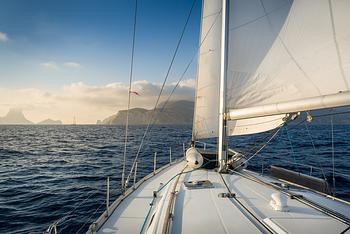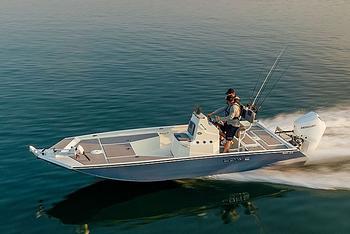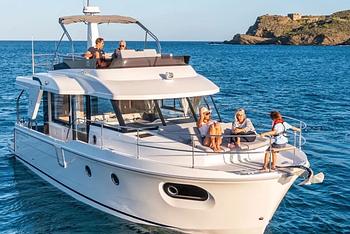The planet is in peril, and superyacht owners are on the frontline in the development of new technologies. Sustainability in the superyacht world is a hot topic, and reducing carbon emissions, protecting the oceans, and being eco-conscious are not just desired but necessary for the industry – and more importantly the planet - to move forward. Superyachts are at the forefront of innovation, the pioneers of design, engineering and technology and for years we have seen an emergence of ever more ‘green’ superyachts sailing out of the shipyards of the top manufacturers.
So what makes an eco-friendly superyacht? And to what extent can the industry minimise the impact yachts make on the environment? We have looked at ways that boat owners can take steps to be more environmentally responsible, but here we dive deeper and take a look at some of the most eco-friendly superyachts on the water today, as well as the future concepts making waves with their forward-thinking ideas.
Hybrid Propulsion and Beyond
Hybrid engines have been one of the main developments in the superyacht industry’s green crusade, and today the number of hybrid superyachts for sale is higher than ever before. The most common type is a combination of diesel and electric propulsion, allowing yachts to cruise at speed using a fraction of the fuel they would with a wholly diesel engine. Yet there are many combinations in testing and construction, from electric turbines, to diesel, LNG (liquid natural gas), battery banks, propellers and waterjets. The right combination can reduce emissions by 30%.
Appealing in many ways, hybrid engines allow for a significant saving on fuel costs, as well as a delightfully quiet and gentle ride when under way. And of course the emissions are hugely reduced, meaning less greenhouse gases and a vastly smaller carbon footprint. Yet it’s not just underway that hybrid propulsion works its magic. With increased battery power, the need for diesel generators at anchor is eliminated, again creating a quiet at-one-with-ocean atmosphere as well as the all-important reduction in carbon emissions.
Feadship’s Savannah was one of the first to use hybrid when she was launched in 2015 and has paved the way for subsequent new builds with ever-more daring technologies. The 80m Artefact, delivered by Nobiskrug Yachts in 2020, combines a revolutionary hybrid propulsion system with 75.5m of solar panels and dynamic positioning – allowing her to keep her position without need for anchors. It is no wonder she was one of the first yachts to meet IMO Tier III emissions regulations.
No article on eco-friendly boats would be complete without mentioning Oceanco’s Black Pearl, a 106.7, sailing yacht which was delivered in 2016 and has set the bar for its eco-credentials. With help of regenerative properties such as solar panels, she can cruise across the Atlantic at speeds of between 12 and 17 knots on just 20 litres of fuel, at the same time converting that power into electricity which is stored in huge battery packs.
Resources
In every part of the design and build of a new superyacht, thought is being placed on how to minimise the vessel’s impact on the environment. Down to the smallest details, thought is put into using renewable resources, ensuring they don’t have a negative impact on the planet. Materials are being sourced as locally as possible to reduce the carbon footprint from shipping them globally (as well as profits being put back into the local economy), and sourced from sustainable avenues. Rare timbers from old-growth forests are being replaced with composite materials for hulls, decks and masts, and accessories must be compliant with CITES (Convention on International Trade in Endangered Species of Wild Flora and Fauna).
Manufacturing
From deep displacement hulls, which allow for a smoother ride in even the roughest of seas, to specialist waste treatment facilities, eco credentials run the whole gamut of superyacht design. But shipbuilders are looking beyond the vessels themselves and putting efforts into reducing the carbon footprint of their manufacturing processes. In Feadship’s Amsterdam facility, over 2,000 solar panels are used to generate power, there is energy-saving LED lighting, and heating is supplied through innovative use of using excess energy from nearby factories. Likewise, Lürssen has developed a filtration system which lowers nitrogen oxide levels (the gas responsible for acid rain).
Owners and charterers too can get involved in the efforts to save the planet, with shipbuilders such as Lürssen, Benetti and Feadship, as well as many charter agencies, offering the chance to offset their yachts or charter holidays. Blue Marine Foundation (BLUE) is a UK-based charity which tackles over-fishing and promotes marine biodiversity, and it pledges to put 30% of the oceans under active and protection by 2030. New superyacht clients can support the charity, either by a one off payment as a percentage of the price, or an annual donation based on the distance cruised.
Ocean Research Data Collection
Every superyacht owner can join the battle to save the oceans through research and data collection. It is impossible to collect data from the entire world’s oceans, even for REV Ocean, the 181.6m superyacht come research vessel. The gargantuan explorer superyacht hosts charterers as well as a team of the finest environmental scientists as they gather vital data using state-of-the-art equipment. As the epitome of explorer superyachts, REV Ocean is a pioneer in ocean research. Yet she will need all the hlpe she can get, and by attaching straightforward data collection systems to their yachts, owners can contribute data on water temperatures, salinity, pollution and oxygen levels.
The Future
Concept yachts play a vital role in development, and while not all will make it into production, it is their ideas, innovation and ability to turn heads and start conversations that makes them such an important part of the superyacht industry. Eco-conscious yachts are always high on the concept yacht agenda, with ever more daring technologies to get the heart pumping.
The 112m AQUA superyacht by Sinot Yachting would be fuelled by liquefied hydrogen which is then converted into electrical energy and stored in battery packs – essentially using water to propel the yacht through the water and whose only byproduct is water.
Vripack’s Future concept yacht is tackling carbon emissions in a different way, using an enormous kite on an electric winch to charge its batteries. The kite circulates above the yacht and turns the winch, generating all the power needed to charge the batteries. The result is fully fossil fuel-free battery charging. Whether it’s 100% solar and wind power such as the systems proposed on Rene Gabrielli’s futuristic catamaran design, or Phillip Briand’s 62.84-metre SY200 sailing yacht, or a new breed to sail-powered superyachts (not to be confused with a sailing yacht) such as Nuvolari Lenard’s 100m Project Vento, the future road is most certainly greener.
Join the Green Superyacht Revolution
As a superyacht owner or charterer you have to power to make a huge impact in the protection of the oceans and the environment. By choosing sustainable resources and technologies, by asking charter and sales brokers about a yacht’s eco-credentials, and by buying eco yachts, you can join the movement to protect our oceans. Rightboat.com offers a vast range of eco-friendly superyachts for sale, and can connect you with brokers with in-depth knowledge in this field.



